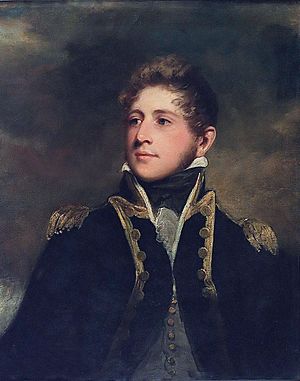Sir Peter Parker, 2nd Baronet facts for kids
Quick facts for kids
Sir
Peter Parker
|
|
|---|---|

Captain Peter Parker (John Hoppner)
|
|
| Born | 1785 |
| Died | August 31, 1814 (aged 28–29) Kent County, Maryland |
| Buried | |
| Allegiance | United Kingdom |
| Service/ |
Royal Navy |
| Years of service | 1793–1814 |
| Rank | Captain |
| Commands held | HMS John HMS Weazel HMS Melpomene HMS Menelaus |
| Battles/wars | |
| Spouse(s) |
Marianne Dallas
(m. 1809–1814) |
| Children | 1 |
| Relations | Sir Peter Parker (grandfather) John Byron (grandfather) Lord Byron (cousin) |
Sir Peter Parker, 2nd Baronet (born 1785, died 1814) was a brave officer in the Royal Navy (the British navy). He came from a family of important naval leaders.
Contents
Peter Parker came from a family of important naval officers. His grandfather was Admiral Sir Peter Parker. His mother's father was Vice-Admiral John Byron.
He went to Westminster School before joining the Royal Navy in 1798. He served on the famous ship Victory under his grandfather and his grandfather's friend, Lord Nelson. Peter Parker quickly moved up the ranks. In May 1804, he became a Commander.
The next year, he took charge of the small warship brig Weazel. The Weazel was the first British ship to spot the French and Spanish fleet leaving Cádiz. This sighting led to the famous Battle of Trafalgar. Because of this important service, he was promoted to Captain.
Serving in Parliament
For a short time, Peter Parker was a Member of Parliament. He was chosen without opposition to represent the area of Wexford in Ireland. This happened in March 1810. He left this role in 1811.
In 1810, Captain Parker was given command of the frigate Menelaus. Soon after, his ship helped with a problem on another French ship, Africaine. The crew of Africaine was protesting against their new captain. Parker's ship was ordered to be ready to fire if the crew did not agree to allow the captain on board. Luckily, the crew eventually agreed, and Menelaus did not have to fire.
In the summer of 1810, Parker sailed to the Indian Ocean. He joined other British ships fighting near Île de France. He helped capture the island in December 1810.
In 1812, Menelaus was part of the blockade of Toulon in the Mediterranean Sea. They stopped ships and attacked small ports along the southern coast of France. In 1813, the frigate moved to the Atlantic Ocean. It helped protect merchant ships traveling to Canada during the War of 1812. Menelaus also attacked American positions along the Maryland coastline. They destroyed a group of coastal ships in September. In 1814, Parker was ordered to fight French ships in the Atlantic. He recaptured a valuable Spanish merchant ship in January.
The War of 1812 and His Final Battle
In 1814, after France surrendered, Menelaus was sent to the North American Station. It went to Bermuda, an important British naval base. During the American War of 1812, British forces used Bermuda to block the American Atlantic coast.
In August 1814, a large group of British soldiers arrived in Bermuda. These soldiers were meant to attack American areas in Maryland and Virginia. They were also used to attack Washington, D.C. in the Chesapeake Campaign. This led to the British winning the Battle of Bladensburg and burning parts of Washington.
From Bermuda, Parker joined the British forces in the Chesapeake Bay. He helped block Baltimore. He was known for being a bold and effective commander. He also became known for destroying American farms and property along the Chesapeake.
On the night of August 30, 1814, Parker led a group of his men ashore. He planned a night attack on American militia in Fairlee, Maryland. Parker had recently freed four enslaved people from a plantation. One of them told him about an American militia unit nearby. Parker landed his ship at Tolchester, Maryland, and had the enslaved person guide him.
He met resistance from the 21st Maryland Militia. This group was led by Lt. Colonel Phillip Reed. The fighting happened in a cornfield belonging to Isaac Caulk. This battle is known as the Battle of Caulk's Field.
During the battle, Parker was leading his marines when he was shot in the thigh. Sadly, unlike his grandfather who was also shot in the thigh but survived, Parker died on the field. A midshipman named Frederick Chamier said that when Parker fell, the energy of the British group faded. Parker's last words were, "I fear they have done for me... you had better retreat, for the boats are a long way off." He bled to death in about 10 minutes. Fourteen men under Parker's command died at Caulk's Field. Twelve of them are buried in unmarked graves at the battle site.
Parker's body was first sent to St. George's, Bermuda. He was buried at St. Peter's Church on October 14, 1814. Later, his body was moved to England. He was re-buried in the family vault at St Margaret's, Westminster. A public funeral with military honors was held for him in both places. His cousin, Lord Byron, who was a famous poet, spoke highly of him.
Family Life
Peter Parker married Marianne Dallas. She was the daughter of Sir George Dallas. They had three sons:
- Commander Sir Peter Parker, 3rd Baronet (1809–1835)
- Another son who died before 1835
- George Parker (born February 1815 – died November 1817), who died from a serious throat infection called croup.

